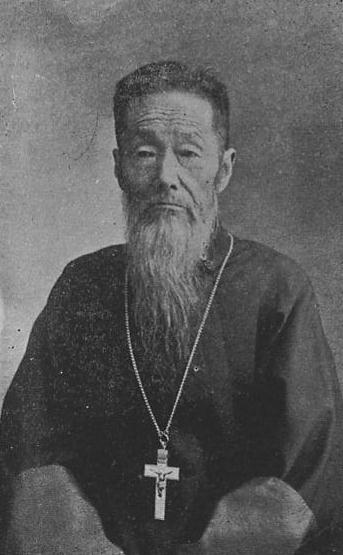Takuma
Sawabe was born in 1833 in Kochi prefecture. His
original name was Yamamoto Kazuma. He was a student, with a
cousin, of the samurai art of Ken-do (Japanese swordsmanship)
and philosophy. In 1857, while walking off some heavy
drinking, Yamamoto ended up with two watches stolen by his
cousin, but which he tried to sell. Yamamoto fled to
Hakodate to escape the police who had identified him as
having stolen the watches. In Hakodate, Yamamoto married the
daughter of a Shinto priest named Sawabe. Yamamoto, after
marrying the priest's daughter, became an adopted son of the
priest and changed his name. Under his new identity Takuma
Sawabe did not participate in the Shinto priesthood, but led
a group that reverenced the Emperor and demanded expulsion
of the foreigners. The Russian Consulate in Hakodate became
a target of their plan for assassinations.
One night
in 1865, armed with a sword, he confronted the Hieromonk
Nicholas with the intent of killing him before he did any
preaching. In the exchange of words that followed, Nicholas
questioned why Sawabe would kill him without hearing about
what Nicholas would have to say. So, Sawabe asked Nicholas
to tell him about his Christian religion. As the young
missionary talked, his words softened Sawabe's heart, his
interest increased, and he began to study the Christian
doctrine. Soon, Sawabe was joined by a doctor friend, Sakai
Tokurei, in a discussion group. They in turn were joined by
two more friends, Urano and Suzuki, and so the group of
catechumens grew. They themselves began teaching about
Orthodox Christianity to other Japanese people. Yet at this
time, the Japanese policy was still to persecute Christians
and forbid conversion to Christianity.
Then in
April 1868, with the Reader Bissarion Sartoff guarding the
consulate office door, Nicholas baptized Sawabe, Sakai, and
Urano with the baptismal names for Paul, John, and James
respectively. They had become the first Japanese people to
accept Orthodox Christianity. With their baptism Paul and
his friends went on to preach their new religion more
fervently.
As the
threat of imprisonment and perhaps even execution increased
in the Hakodate area, Hieromonk Nicholas sent Paul and his
friends to travel else where in Japan to preach their new
faith, but ultimately to gain greater safety for them. Not
hearing from Paul for some months, Hieromonk Nicholas was
very glad to receive news from Paul of his successes in
Sendai, in northern Honshu. In time the opposition to
Christianity subsided, and the now Archimandrite Nicholas
began to look to expanding his missionary work to Tokyo.
It was
Paul Sawabe whom Nicholas sent to Tokyo to review the
situation for missionary work in the Tokyo/Yokohoma area and
advise him of the potential for such work there. Paul's
report was one of optimism, and Paul advised Nicholas to
come to Tokyo as soon as possible. So, in late January 1871,
Archimandrite Nicholas arrived in Yokohoma and proceeded to
Tokyo to set up his headquarters.
Local
opposition to Christianity was still present. In February
1872, Paul Sawabe and many of his co-workers in Christ were
arrested by the local police in Sendai. The officials were
amazed that even among the children their answers to
questioning showed a deep conviction to their Christian
beliefs. Even though many had not been baptized none changed
their position but were strengthened in their faith.
On July
12, 1875, at the second General Council of the Japanese
mission, Archimandrite Nicholas decided that there was a
need for native clergy, and named Paul Sawabe to be the
first priest, and that John Sakai would be a deacon. A month
later Bishop Paul of East Siberia came to Hakodate for the
first sacraments of the Holy Orders in Japan and ordained
the new priest and deacon.
Paul
Sawabe continued to service his new faith as his church grew
over the following decades. He was to survive his mentor and
bishop by a year, dying in 1913.
